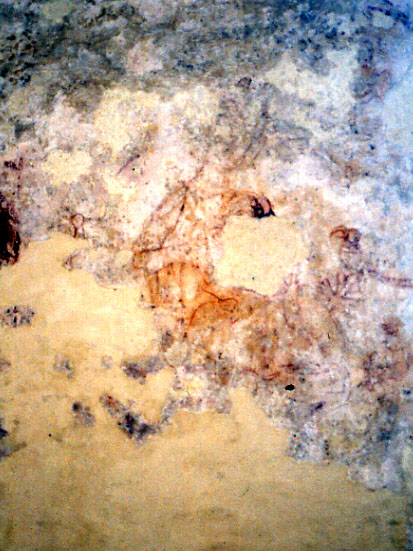Hardwick, Cambridgeshire (†Peterborough) Early C.14
Charlemagne’s Dream of St Cyriacus
A very unusual painting, the Legend of the Hairy Anchorite at Idsworth in Hampshire, was newly on this site at the last update. If anything, this painting of Charlemagne’s Dream of St Cyriacus at Hardwick church in Cambridgeshire, is an even more unexpected subject to find in England, but I am certain that that is what it is, just as CE Keyser thought in his List of Buildings having Mural Decorations… of 1888 (p.122).

The story behind the painting is as follows: Sometime after his coronation, the Holy Roman Emperor Charlemagne (d.814) called together his bishops to ask about a strange dream that he was anxious to know the meaning of. He dreamed that during a hunting party, he was attacked by a ferocious wild boar; unable to fight it off, he prayed briefly, but intensely, for help; as a result a naked infant appeared and said to him “If you will give me something to dress myself in, your life will be saved”. To this Charlemagne agreed, whereupon the child straddled the boar and brought it to the Emperor's feet, where he killed it easily. Jerome (later Saint), bishop of Nevers from 795 to 815, interpreted the dream thus: “The naked child was the young St Cyr, martyred at Tarsus in 304 and the protector of my poor cathedral. The clothing he asked you for must mean the money needed to restore the cathedral and the diocese”. (On bishop Jerome’s arrival at Nevers, the cathedral church had been in a very poor state, the diocese itself ill-defined and reduced to penury after the depredations of Pepin the Short, the last Merovingian king of France).

Charlemagne accepted Jerome’s interpretation, had all the stolen treasures of the cathedral returned to Nevers, and endowed it with still greater riches. Bishop Jerome went on to redefine the diocese, as well as building and rebuilding numerous churches and abbeys. Nevers Cathedral, formerly under the protection of SSt Gervase and Protase, was, along with the entire diocese, re-dedicated to the child-martyr St Cyriacus and his mother St Julitta, a dedication that was to prove definitive and uncontested. A happy mutual outcome for a great Emperor and unifier of Christendom and a shrewd businessman-bishop: the two clearly understood each other.
The black-and-white sketch above should make the now very faded painting of the young St Cyriacus astride the wild boar clearer. Cyriacus, otherwise Quiriacus, or Cyr, was indeed martyred with his mother Julitta, a Roman widow, under Diocletian, and a surprising number of English churches are dedicated to him, the best known being Lacock Abbey church in Wiltshire. But he obviously had his devotees on the other side of England too. Hardwick is close to Cambridge, and it seems probable that a scholarly incumbent in the early 14th century was responsible for this particular choice of subject.
There is another painting at Hardwick, the Seven Deadly Sins in wheel-diagram form. It too is desperately faded, but I will try to include it at a future update.